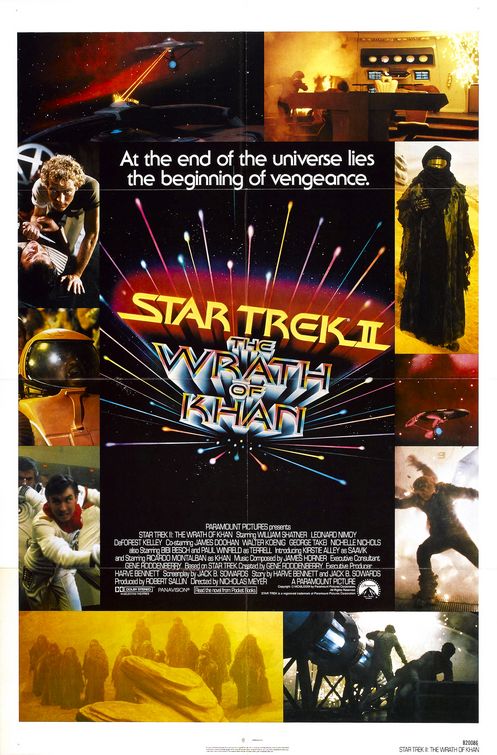
Nordling here.
My New Year’s Resolution this year was to write more features and editorial articles. I’m taking much of this from Film Critic HULK at Badass Digest, who, in my opinion, offers some of the finest movie discussion on the Internet right now. Now, I have no idea whether or not this will develop into a column. In fact, you could see it as a continuation of a column that Drew McWeeny started in 2007, which was our 1982 retrospective. At the time, 25 years had passed since that wonderful genre year, with movies like E.T., BLADE RUNNER, John Carpenter’s THING remake, POLTERGEIST, TRON, THE ROAD WARRIOR (MAD MAX 2 to those of you across the pond), and many others. It was a great year for geek movies, and many of our readers now weren’t even born then so if you think this is just some trip down memory lane by some balding geek then feel free to click away. In fact, I want to make this something of a nostalgia-free zone anyway, but I’ll get to that in a minute.
(And this is an aside, but if you want to read a tremendously great breakdown of POLTERGEIST, go to Badass Digest and read Devin Faraci’s write-up about the film, the controversy behind its making, and the legacy that makes the film an undisputed horror classic 30 years later. A two-part article, read Part I here and Part II here.)
So, CLASS OF ‘82 is an attempt to talk about those great movies that year with some kind of analysis, a little (but not much) retrospective, and an exploration of why those films are not only as beloved as they are, but why they turned out as good as they did. It’s easy to look back through the years with fond memories of childhoods past and better times, but I actually want to avoid that if possible, because, simply put, these movies are great without all that extraneous bullshit. BLADE RUNNER doesn’t need nostalgia – it’s amazing all on its own without the filter of time buffing the edges off. I’ve already been down memory lane when it comes to a movie like E.T. That’s not what this is about, and if I ever decide to write something about E.T. again I’ll do my best to avoid all that and concentrate on just what makes that movie work as well as it does. What’s much more likely, though, is that I’ll skip that one altogether, or have someone else write something if they’re interested, because I think I’ve said all I need to say on that movie at this point. So…
I’ve been under the weather this past week, so I haven’t been posting at full strength. Plus, it’s just a slow news cycle in general for movie news – if it’s not a best of list or Oscar talk, most news is held off until February or so. So I’ve been spending much of the time watching movies at home, and this week STAR TREK: NEMESIS was on cable, so I watched it. I hadn’t seen it since release, and I remember it as being pretty bad – nowhere near the cinematic horror show of INSURRECTION, but close. NEMESIS finds a way to screw up a Tom Hardy performance as the villain, and the fact that he pulled his career out of this tragedy says a hell of a lot about his skills as either an actor or self-promoter, I’m not sure which. But this time, maybe it was the cold rattling my brains, NEMESIS didn’t play that badly. I’m under no illusions – I recognize NEMESIS as a terrible movie – but for someone just looking for something to play in front of me while I coalesced, NEMESIS was just the ticket.
But NEMESIS has a major problem, a problem shared by many of the STAR TREK films, including Abrams’ – it wants to be STAR TREK II: THE WRATH OF KHAN so badly that the movie suffers for it.
As far as comfort movies go, for many of us, you can’t beat the STAR TREK films. Are many of them bad movies? Absolutely. In a way, the best film of the series, STAR TREK II: THE WRATH OF KHAN, broke all the movies after it. Even J.J. Abrams' reimagining, which I love, gets by more on a ton of charm than good story. If J.J. Abrams’ STAR TREK were a pig, Samuel Jackson would eat it. STAR TREK IV: THE VOYAGE HOME probably is the most successful TREK film because it strayed away from that KHAN template and became something unique on its own. Even when Nicholas Meyer returned for THE UNDISCOVERED COUNTRY he realized that KHAN shouldn’t be repeated, and instead told a more political story that was wider in scope. But many of the TREK films after KHAN keep trying to return to that well, and keep trying to catch that lightning again, but what those subsequent films fail to realize is that it’s not just one thing that made KHAN so great. It was many.
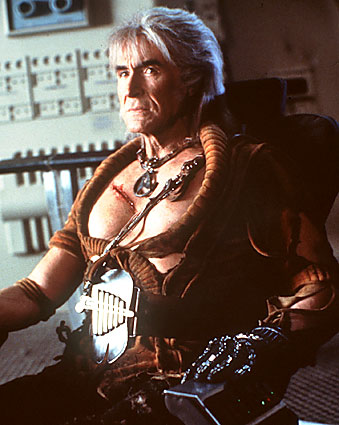
You can’t deny that KHAN has a great villain, easily the best in the franchise. Ricardo Montalban is so good as Khan, in fact, that you sympathize with him a lot more than other sympathetic villains. After all, he’s right. Kirk did abandon him on Ceti Alpha V. He may not have realized what was going to happen to Ceti Alpha VI, but he at least could have checked them out, if for nothing else a sense of duty. Khan Singh was a tyrant on Earth, and Captain Kirk could have checked now and then to see that Khan wasn’t up to any mischief. Even before they dropped Khan and his crew off, they could have checked the stability of the nearby planet. And yet, maybe there was nothing that Kirk could have done. But he still was responsible, and once Kirk made the decision to abandon them to their fate, the die was cast. Khan’s anger feels righteous and honest, and Montalban plays Khan as so wounded by his loss that it strips him of reason. There is always a part of me that wants Khan to win. The TREK films since have never achieved that kind of sophistication with their villains.
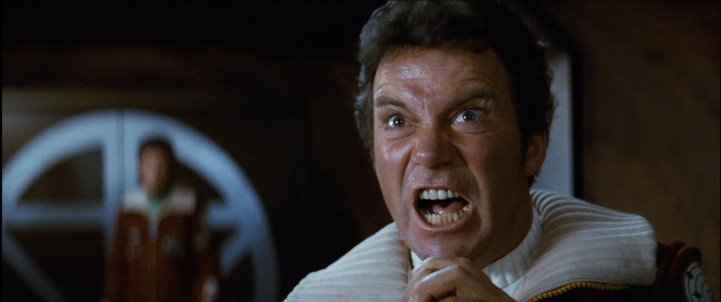
If Khan was such an amazing villain due to Ricardo Montalban’s terrific performance, he’s matched by William Shatner’s Kirk, which in KHAN is easily his finest hour as that character. People make fun of Shatner a lot as an actor, and I know that “KHAAAAAANNNN!” is a well-established and quoted line, done in jest, but in the context of that scene? Shatner totally nails it. Kirk is completely helpless, for the moment, to Khan’s machinations. His scream is full of impotent sound and fury, and I think the reason it’s so loved is that it works so well. But Shatner creates a rich character this time around, a Kirk dwelling on his mortality, and his place in the universe, and he is a man who knows in his heart that he hasn’t done right by a lot of people in his past. He feels as if the ambitions and hopes of a young James Kirk have fallen to the wayside as this older, bureaucratic man has taken his place, babysitting recruits while standing behind a simulator. The dynamic between Kirk and Khan wouldn’t be anywhere near the same if Abrams decides to bring the character into any sequels. These are two men fighting, one to avenge the losses of his life, and one to prove that he still matters, that he can still make a difference, and who is trying to correct the wrongdoings of his past.
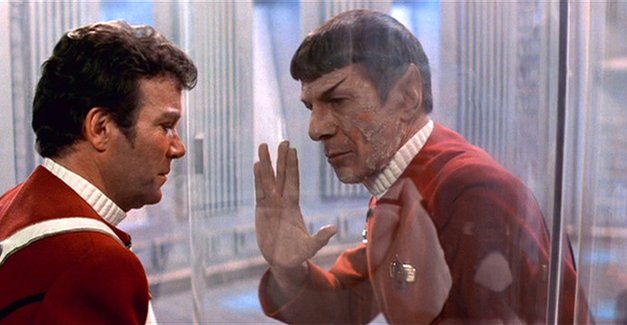
In NEMESIS, Commander Data decides to sacrifice himself to save the Enterprise, but since it not only has been done before in KHAN, the character itself is given a reboot inside the movie, which gives the sacrifice absolutely no weight. When I first saw KHAN in 1982, audiences weren’t given that kind of reprieve, even with the extraneous coffin shot at the end. I remember hearing a lot of crying in the audience that night, and the only reason I didn’t join in at the time was because I wasn’t as familiar with the character as I am now. But Spock’s sacrifice should resonate with anyone who has ever lost a friend to tragedy. “The needs of the many outweigh the needs of the few.” “Or the one.” It’s a moment of great nobility for the character, and part of me has always wondered what it would have been like if the character simply never returned to the franchise. Of course, he did; fans demanded it and even Leonard Nimoy himself had second thoughts at the wrap party, where he famously told Harve Bennett that he looked forward to returning in the next movie. Knowing that Spock does come back takes some of the sting out of it, but if you watch the movie without that baggage it becomes one of the best goodbyes from any long-standing genre character in science fiction history. Even the way he adjusts his shirt as he stands before his Captain for the last time is one of those wonderful moments that I tend to think about when remembering this scene. Spock and Kirk, separated by a barrier, also make that scene work so well. Nicholas Meyer knew that restraint and subtlety carry more emotional weight than any histrionics and overacting ever could. It’s an appropriately quiet moment. And that scene may well be the pinnacle of acting for both Leonard Nimoy and Shatner.
Spock’s death just helps accentuate the bigger themes of THE WRATH OF KHAN – the fear of dying, the fear of growing old, and not serving your purpose. The television show was about Big Ideas; it prided itself on that. And yet, it was rare that the film franchise ever achieved such lofty heights, even with all the budget in the world. Well, THE WRATH OF KHAN was all about Big Things and Big Ideas. What’s more, the filmmakers weren’t afraid of sometimes stopping the movie cold to explore them. Take the scene in Kirk’s apartment, when McCoy comes by to give his birthday wishes to Kirk. It’s a wonderful character moment for the both of them, and it sets up practically everything thematically for the rest of the movie, and it barely moves the plot forward at all. Then there is the central conceit of the movie, or as Spock puts it, “the needs of the many.” STAR TREK was always about the needs of the many. Gene Roddenberry’s grand vision of an Earth in unison, together regardless of religion, creed, or background, exploring our future together, was never as strongly portrayed as in KHAN. While, again, I love J. J. Abrams' reboot, that concept is barely there now. Spock walks the walk as he goes down the ladder to his destiny, and the fact that he does something that doesn’t occur to Kirk until it’s too late says a lot about Kirk and Spock as characters.

Death permeates all through WRATH OF KHAN. Khan himself is a symbol of it – relentless, always coming, always inside Kirk’s shadow and over Kirk’s shoulder. Even though Montalban and Shatner never share the screen, you feel his presence throughout Shatner’s scenes, and while much of that is due to Montalban’s iconic performance, it’s also due to how the story links Khan with death thematically. Kirk must face his mortality if he is to move forward as a person, and KHAN is about how we deal with that in our own way. Kirk’s cheated looking death in the eye for his entire life and now has to pay for skirting it as long as he has. “I don’t believe in the no-win scenario,” Kirk says confidently, but life itself is a no-win scenario. You come out of it losing everything. In WRATH OF KHAN Kirk struggles with the concept of death and comes out stronger on the other side. “Young… I feel young,” he proclaims, because at long last Kirk understands his own significance and place in the universe. To reference a much later film, Kirk has his staring-out-the-window-at-the-end-of-the-world moment from FIGHT CLUB and comes away from it a changed, and better, man. In short, Kirk grows up.
Nicholas Meyer knew, even if subsequent TREK directors didn’t, that dealing with big ideas and themes made a film seem bigger in scale than if it had a huge budget and huge special effects. THE WRATH OF KHAN is extremely intimate for a STAR TREK film – perhaps it was due to the reduced budget, the very low set count, or the excesses of the first film – but it never feels small. Even the final battle, set against the background of a stormy nebula, isn’t about scale or grandeur but about two men facing off for the last time, and their emotional battle is even broader than the actual one. It’s a game of chess played on the board of the vastness of space, and it remains one of the most intense climaxes in movie history. And as Khan lives his final moments, he decides to be defined by his hate and grief, and becomes the instrument that will end Kirk’s life. As he has usurped the powers of creation for his own vengeful purposes, he will strike out at his enemy, like Ahab throwing himself upon the whale. STAR TREK II uses MOBY DICK so well that the book shows up later in the film series, as Captain Picard deals with his own Ahab issues against the Borg. But it’s never used so successfully – Nicholas Meyer, who is a Renaissance Man in the best sense, knows how to strike the balance of theme and plot and makes those moments stick in memory.
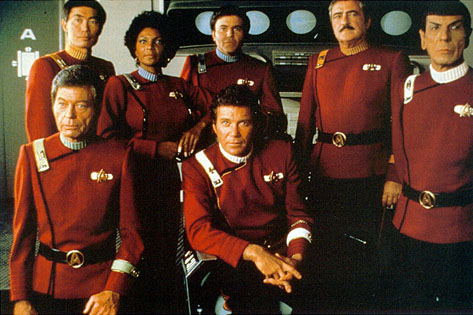
I know there are many fans of the franchise that have serious issues with the new TREK iteration - with Abrams’ direction (seriously, lighten up on those lens flares), the young cast, or Alex Kurtzman and Roberto Orci’s script, which if taken apart critically really doesn’t make nearly as much sense as it appears to onscreen. As I’ve said, STAR TREK gets by on an awful lot of charm. So many of the films that come after WRATH OF KHAN try to capture that magic again, and I want to tell them all that it’s not possible. Furthermore, they threaten to dilute that great film with each attempt. It seems to me that what those writers fail to realize is the basic fact that THE WRATH OF KHAN is so great because of many variables, and not just how successful the villain is. THE WRATH OF KHAN means something. It takes us on an emotional journey, and it isn’t just a thrill ride. It’s rich with feeling, honest in its portrayal of mortality, age, and friendship, and it respects the audience enough to take them through those feelings without dumbing down to them. KHAN is the prime example of how filmmaking, done with restraint and temperance, can be much more effective than a film with an unlimited budget and unnecessary scale. If there’s anything I want the filmmakers of the new TREK films to understand, it’s that.
Like I said, I don’t know if this column is going to be a thing or not. I’m throwing it out there to readers who might be interested in writing about their favorite 1982 film, or even any filmmakers who might be interested in doing so. I’m not so much interested in the nostalgia behind the movie as I am in what makes the movie work for you, creatively. As always, thanks for reading.
Nordling, out.
